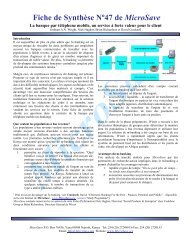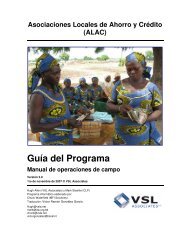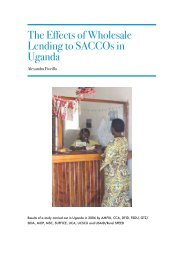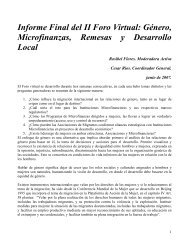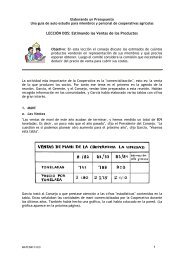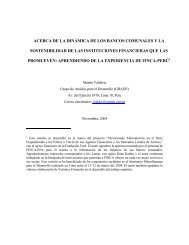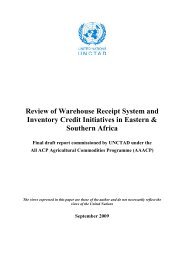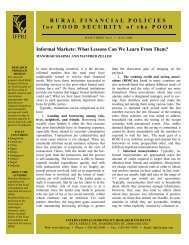Finance - Rural Finance Learning Center
Finance - Rural Finance Learning Center
Finance - Rural Finance Learning Center
You also want an ePaper? Increase the reach of your titles
YUMPU automatically turns print PDFs into web optimized ePapers that Google loves.
<strong>Finance</strong> Study Guide Lesson 5<br />
Write-offs<br />
Once it has been determined that the likelihood of a loan being repaid is remote, a<br />
write-off occurs. Write-offs only occur as an accounting entry and do not mean<br />
that loan recovery should not continue to be pursued if it makes economic sense.<br />
Writing off a loan does not mean the organization has relinquished its legal claim to<br />
recover the loan.<br />
As described in the Accounting Study Guide, write-offs are made against the Loan<br />
loss reserve previously established and therefore do not affect the net portfolio<br />
outstanding unless an increase in the Loan loss reserve is made. To determine the<br />
rate of loan losses for a specific period (annual), the Loan Loss Ratio is an<br />
important indicator. The Loan Loss Ratio refers only to the amounts written off in<br />
a period and the ratio is not related to the Loan loss reserve except in that writeoffs<br />
reduce the Reserve.<br />
To determine the amount written off in a period, calculate the difference between<br />
the Loan loss reserve from the previous period and that of the current period, and<br />
subtract the provision made during the current period. If the result is negative,<br />
this is the amount written off; if positive, a loan previously written off was<br />
recovered during the current period.<br />
Loan Loss Ratio = Amount Written Off in Period<br />
Average Portfolio Outstanding for the Period<br />
This ratio can be compared over time to see if write-offs as a percentage of<br />
outstanding portfolio are increasing or decreasing. Refer to the following Portfolio<br />
Quality Ratios which were created from the Income Statement, Balance Sheet and<br />
Portfolio Report in the Sample Account Analysis. Go through each of the ratios.<br />
(You will complete the ratios for 1995 in the “Delinquency” Exercises.)<br />
Portfolio Quality Ratios 1994 1993<br />
Portfolio in Arrears Payments in Arrears<br />
Value of Loans Outstanding<br />
0.13 0.19<br />
Portfolio at Risk Balance of loans in arrears<br />
Value of loans outstanding<br />
0.29 0.38<br />
Loan Loss Ratio Amount Written off<br />
Avg. Loans Outstanding<br />
0.05 0.00<br />
Reserve Ratio Loan loss reserve<br />
Value of Loans Outstanding<br />
0.07 0.10<br />
Rescheduling and Refinancing Loans<br />
When a client is unable to repay her loan due to illness, disaster, mismanagement<br />
or some other crisis, there are times when it is appropriate to reschedule or<br />
refinance the loan. Rescheduling a loan refers to extending the loan term and/or<br />
changing the payment schedule. Refinancing refers to providing an additional<br />
amount of loan funds to the original loan amount. This allows the client to begin<br />
making the loan payments again and, it is hoped, continue until the loan is paid in<br />
full. Rescheduling or refinancing loans is very risky and must only be done under<br />
extreme circumstances as a way of ensuring that the entire loan is repaid.<br />
Rescheduling or refinancing loans reduces the arrears in a portfolio by converting a<br />
delinquent loan into one that is suddenly a loan with no arrears, even though the<br />
risk has not necessarily been reduced and may in fact be higher due to the<br />
rescheduling or refinancing. All rescheduled loans should be monitored separately<br />
and with additional care. They should not be reported as healthy loans in the<br />
portfolio.<br />
Calmeadow 10




